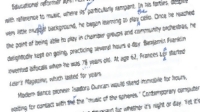Sparking Demand: Seven Ways to Perk Up a
Dull Offer
by Marcia Yudkin
So you launched your
product with a lot of fanfare and hardly
anyone bought? If you're convinced the
product fulfills a marketplace need and your
description of it was compelling and clear,
the problem probably lay in your offer. Use
these seven techniques to awaken potential
customers from their indifference, overcome
their reluctance to make a commitment and
inspire them to buy.
1. Scarcity. As
long as you can provide a credible reason
for limiting the number of sales of your
item, interested people respond now to
scarcity because they don't want to be
locked out. Of course it's easier to explain
why supplies of tangible items are limited
or why you have a limit for events, where
only a certain number of people can be
seated or served. Still, you can justify a
cut-off point for sales of a digital item so
that the information retains value for those
who purchased or because of a promise to
some third party.
|
Learn to Present
Teleseminars Comfortably and
Profitably
My online course, Teleteach for
Profit, gives you the straight
scoop on what you should and shouldn't do in your teleseminar program and why.
As a novice, you'll go from feeling nervous about leading an audio session to using teleseminars
confidently for generating prospective customers or as a profit center in
themselves.
Course details. |

Teleteach for Profit Course |
|
2. Payment plan.
Often people want to buy but hold back
because of cost. That's why dividing the
cost of a comparatively expensive item into
multiple installments encourages sales.
Enrollment in my marketing seminars rose
dramatically when I presented the fee as
four installments of $299 or three
installments of $333 instead of $995 all at
once. One of my colleagues says that payment
plans even for a program in the range of $95
- $150 work well for her in encouraging
folks on the fence to sign up.
3. Discount for first
customers. Here you cut the price for
the first X buyers, which motivates people
to step up to the plate and make a
commitment. Note that this offer works best
when customers trust you to carry on exactly
as you've described, rather than end the
discount early, lie about how many people
have bought or keep the offer running
indefinitely.
4. Emphasize the
defects. Normally you want to describe
your offerings in the best possible light.
However, advertising experts can cite many
instances where they took an item no one
wanted, explained what was wrong with it and
began racking up sales at the very same
price as before. For instance, motorists
didn't rush to buy little Volkswagen Beetles
when they were first introduced. A series of
ads making light of the car's tiny size
turned that around - such as the ad with the
headline, "And if you run out of gas,
they're easy to push."
 |
Improve Your
Proofreading
Quick online course teaches how to
catch pesky typos. Whether you check
writing on screen or on paper, learn the
stakes for error-ridden copy, the five
best proofreading methods and the tools
you can or shouldn't use to identify
errors. Includes practice tests and
answers.
Proofreading Hacks course. |
5. Free preview.
Perhaps customers weren't buying because
they didn't get a clear enough sense of the
value of what you're selling. Then think of
a way to provide a no-cost preview of what
they get when they buy. For software or a
gym membership, that's usually a trial
period. For a book or report, it's the
ability to take a look at several chapters
without charge. For something that gets
mailed to customers, the preview might
consist of being able to try out the item at
home for 30 days before the credit card
charge kicks in.
6. Choose a bonus.
Internet marketers often get into the habit
of piling on so many bonuses for each
purchase that the bonuses overshadow the
value of the main item being sold. Instead,
try letting the customer choose one of two
to four bonus options. Often this promotes
involvement that sends a customer across the
decision line.
7. Backout option.
Are people leery of getting into something
that's not for them? Does the fear of
buyer's remorse keep customers from saying
"yes"? Then encourage prospects to sign up
and pay, but with the proviso that for a
certain period of time they may change their
minds. This is a type of guarantee, one that
emphasizes the tastes and satisfaction of
the purchaser rather than the possibility of
there being something wrong with what was
purchased.
Offers make a huge
difference in purchase rates. Change the
offer, and you may thereby enjoy a drastic
improvement in cash flow.
Copyright 2012 Marcia
Yudkin. All rights reserved.
Online Courses That May Interest You
Launch Your Information Empire
The Sales Letter Makeover Course
The Press Release Makeover Course
The Mighty Postcard Marketing Course
Create a Practical Marketing Plan
Fact Checking Made Easy






